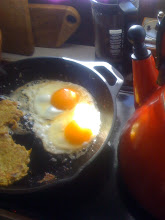
Last Saturday I learned how to harvest a chicken.
I not only learned how, I actually did it, and it wasn't as hard as I imagined it might be--that was all in my head. In reality, even the slaughtering part was very matter-of-fact and simple. Very real. It reminded me of being at a birth. It's not a novel comparison, to equate birth and death, but some might be shocked or offended at my throwing killing an animal into the mix. But when you stop to think about it, killing for food is elemental for humans and animals, it is a part of our DNA, our natural lives. We watch lizards catch insects with no twinges of sadness. We are fascinated with lions eating their prey, looking like our own cats with backyard birds (this is one reason why we watched National Geographic specials, is it not?).
We were a group of ten, gathered at our local CSA on a cool (Miami-style) and glittery Fall day in South Florida. The roosters--noisy boys that they are--needed culling and we lucky ones were about to learn the process of turning bird into dinner. After a few false starts while we discovered just how hard it is to catch a rooster, even in a chicken tractor, we roun
 ded them up into a holding cage. We only needed one demonstration, then we took turns performing each step: slaughter, scald, pluck, butcher, eviscerate. The birds were then washed and iced down. In the end, we had eleven dressed roosters (the extra was raffled off) and a bunch of heads, feet and giblets. I'll do a post on offal another day, but suffice it to say, I ended up with the heads and feet for my stock pot. Though the whole group was very game about the entire project, some things are just very new ideas to us all.
ded them up into a holding cage. We only needed one demonstration, then we took turns performing each step: slaughter, scald, pluck, butcher, eviscerate. The birds were then washed and iced down. In the end, we had eleven dressed roosters (the extra was raffled off) and a bunch of heads, feet and giblets. I'll do a post on offal another day, but suffice it to say, I ended up with the heads and feet for my stock pot. Though the whole group was very game about the entire project, some things are just very new ideas to us all.We sat down at a long table out of the sun and shared a light farm lunch. All the while, we traded recipes and stories, enjoying the company and the day. This is the essence of community in the New Millenium: Sharing skills and joys almost lost to the commodification of our food and our whole lives. To do this we have had to create all sorts of intentional groups, such as CSA's and support groups, schools of herbcraft and so on. I am sure that my great-grandmother learned to make gefilte fish from her mother or grandmother, starting with a live carp (for a wonderful children's story about this, see The Carp in the Bathtub,.) We now have to seek out the mentors and fellow travelers that would have been a part of our natural surroundings in our great-grandparents' time.
I do see that we are starting to value anew the richness of the food of the past. And I think that we really do yearn for the family dinners, the holiday gatherings, the kids who follow ours home, drawn by the warmth and the delicious smells coming from our kitchens. We love the ambiance; this is what Martha Stewart has been marketing with a vengeance for years. And we say we want real, that we
So why do we have suc

Going to a small farm for a chicken-harvesting workshop is not my answer to daily food choices--it was only one bird, after all. Instead, it is a way to respect the animal that would become our dinner, to restore that connection for every chicken going forward. It is a way to see the chicken on the plate as the culmination of a process that is real and tangible. It reaffirms my choice to eat humanely-raised pastured animals, always aware of how they lived.
And slaughtering my own rooster taught that its death is equally full of purpose and integrity.






No comments:
Post a Comment